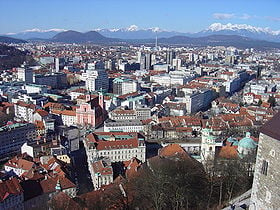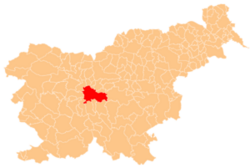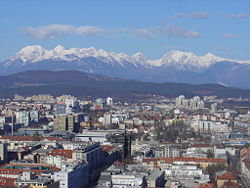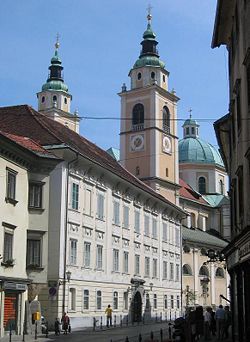Ljubljana
| Ljubljana | |||
| ÔÇö┬á┬áCity┬á┬áÔÇö | |||
| View from the Ljubljana Castle towards the north | |||
|
|||
| Municipal location in Slovenia | |||
| Coordinates: 46┬░03ÔÇ▓N 14┬░31ÔÇ▓E | |||
|---|---|---|---|
| Country | |||
| Municipality | City Municipality of Ljubljana | ||
| First mention | 1112ÔÇô1125 | ||
| Town rights | around 1220 | ||
| Government | |||
|  - mayor | Zoran Janković | ||
| Area | |||
|  - Total | 163.8 km² (63.2 sq mi) | ||
| Elevation [1] | 295 m (968 ft) | ||
| Population (January 2011)[2] | |||
|  - Total | |||
|  - Density | 1,662/km² (4,304.6/sq mi) | ||
| Time zone | CET (UTC+1) | ||
|  - Summer (DST) | CEST (UTC+2) | ||
| Postal code | 1000 | ||
| Area code(s) | 01 (1 if calling from abroad) | ||
| Vehicle Registration | LJ | ||
| Website: www.ljubljana.si | |||
Ljubljana is the capital and largest city of Slovenia. It is regarded as the cultural, scientific, economic, political and the administrative center of Slovenia, an independent country since 1991. Located in the center of the country, Ljubljana lies in a basin surrounded by peaks of the Dinaric Alps. A short tributary of the Sava River, the Ljubljanica River, flows through the city center.
Throughout its history, the city has been influenced richly by its geographic position. Ljubljana lies at the crossroads of Germanic, Latin, and Slavic cultures.
Ljubljana's transportation connections, concentration of industry, scientific and research institutions, and long industrial tradition all contribute to its leading economic position. Ljubljana is the seat of the Slovenia Parliament, and of the office of the President of Slovenia.
Geography
Historians disagree about the origins of the name Ljubljana. It could derive from the ancient Slavic city called Laburus,[3] or from the Latin Aluviana after a flood in the town. Another possible sources include Laubach, which means "marsh," or from the Slavic word Luba, which means "beloved." The old German name for the city is Laibach.
The city, with an area of 106.2 square miles (275 square kilometers), is situated on an alluvial plain in central Slovenia, near the confluence of the rivers Ljubljanica and Sava, at the foot of Castle Hill, at an altitude of 980 feet (298 meters). The castle, which sits atop a hill south of the city center, is at 1,200 feet (366 meters) altitude while the city's highest point, called Janški Hrib, reaches 2,600 feet (794 meters).
The Ljubljana's climate, and that of eastern Slovenia, is of the continental type. July and August are the warmest months with daily highs generally between 25┬░ and 30┬░C (77┬░ to 86┬░F), and January is the coldest month with the temperatures mostly oscillating around 0┬░C (32┬░F). Frost is possible from October through May. The driest months are from January to April. Average annual precipitation is about 1,400 mm (55 in).
A number of earthquakes have devastated Ljubljana, including in those 1511 and 1895. Slovenia is in a rather active seismic zone because of its position to the south of the Eurasian Plate.[4]
A twelfth century castle dominates the skyline of Ljubljana. The old part of the city, which is situated between the fortress and the river, is made up of two districts: one includes Ljubljana town hall; the other, the neighborhood of the Chevaliers de la Croix, features the Ursuline church, and the Slovenian Philharmonic Orchestra building.
After the 1511 earthquake, Ljubljana was rebuilt in a Baroque style following the model of a Renaissance town. Few Austrian Baroque buildings survived the 1895 earthquake. The city was largely rebuilt in the Art Nouveau style that was popular at the time, and in a grid pattern, although the old town on the right bank of the river remained. Fine stone bridges were built across the river. Large sectors were built after the Second World War.
History
Around 2000 B.C.E., the Ljubljana Marshes were settled by people living in wooden structures on pilotis. These people survived through hunting, fishing and primitive agriculture, and used dugout canoes to navigate the marshes. Later, the area remained a transit point for numerous tribes and peoples, including the Veneti, followed by an Illyrian tribe called the Yapodi and then in the third century B.C.E., a Celtic tribe, the Taurisci.[5] The area surrounding Ljubljana castle has been continuously inhabited since 1200 B.C.E.
According to legend, Ljubljana was founded by the Greek mythological hero Jason and his companions, the Argonauts, who had stolen the golden fleece from King Aetes and fled across the Black Sea and up the Danube, Sava and Ljubljanica rivers. They stopped at a large lake in the marsh near the source of the Ljubljanica, where they disassembled their ship to carry it to the Adriatic Sea, and return to Greece. The lake had a monster, which Jason fought and killed. The monster, referred to as the Ljubljana Dragon, is part of the Ljubljana coat of arms.
Around 50 B.C.E., the Romans built a military encampment, possibly on Celtic fortifications, that later became a permanent settlement called Iulia Aemona (Emona).[6] This entrenched fort was occupied by the Legio XV Apollinaris. The settlement was strategically important, located on the route to Pannonia and commanding the Ljubljana Gap.
Emona housed 5,000 to 6,000 inhabitants and played an important role during numerous battles. Its plastered, brightly colored, brick houses were connected to a drainage system.[6] In 452, Emona was devastated by the Huns under Attila's orders, and again later by the Ostrogoths and the Lombards.
In the sixth century, the ancestors of the Slovenes moved in. In the ninth century, the Slovenes fell under Frankish domination, while experiencing frequent Magyar raids.
The name of the city, Luwigana, appears for the first time in a document from 1144. In the thirteenth century, the town consisted of three zones: the Stari trg ("Old Square"), the Mestni trg ("Town Square") and the Novi trg ("New Square"). In 1220, Ljubljana was granted city rights, including the right to coin its own money.
In 1270, King Ottokar II of Bohemia (1230ÔÇô1278) conquered Carniola and in particular Ljubljana. Rudolph of Habsburg (1218ÔÇô1291), defeated him and took the town in 1278.
In 1335, the town became the capital of the Habsburg-Austrian province of Carniola. Renamed Laibach, it would belong to the House of Habsburg until 1797.
The Diocese of Ljubljana was established in 1461 and the Church of St. Nicholas became a cathedral.
In the fifteenth century Ljubljana became recognized for its art. After an earthquake in 1511, it was rebuilt in Renaissance style and a new wall was built around it.
In the sixteenth century, the population numbered 5,000, 70 percent of whom spoke Slovene, with most of the rest using German. In 1550, the first two books written in Slovene were published there: a catechism and an abecedarium, followed by a Bible translation. By that time, the Protestant Reformation had gained ground in the town. Several important Lutheran preachers lived and worked in Ljubljana, including Primo┼ż Trubar (1508ÔÇô1586), Adam Bohori─Ź (1520-1598) and Jurij Dalmatin (1547-1589).
Around the same time, the first secondary school, public library and printing house opened in Ljubljana. Ljubljana thus became the undisputed center of Slovenian culture. In 1597, the Jesuits arrived in the city and established a new secondary school that later became a college. Baroque architecture appeared at the end of the seventeenth century as foreign architects and sculptors came in.
Taken by the French under Napoleon I in 1809, Ljubljana became, from 1809 to 1813, the capital of the Illyrian Provinces.[7]
In 1815, the city again came under Austrian rule, and from 1816 to 1849 was part of the Kingdom of Illyria. In 1821, it hosted the Congress of Laibach, which fixed European political borders for years to come.
The first train arrived in 1849 from Vienna and in 1857 the line was extended to Trieste, stimulating the economic and cultural growth of Ljubljana, which became a center of Slovene nationalism. The city gained a sugar refinery, a brewery, a foundry, and a paper and textile mill. Public electric lighting appeared in 1898.
In 1895, Ljubljana, then a city of 31,000, suffered a serious earthquake, measuring 6.1 on the Richter scale. Some 10 percent of its 1400 buildings were destroyed, although casualties were light. During the reconstruction that followed, a number of quarters were rebuilt in Art Nouveau style.
In 1918, after the end of World War I (1914-1918) and the dissolution of Austria-Hungary, the region joined the Kingdom of Serbs, Croats and Slovenes. In 1929, Ljubljana became the capital of Drava Banovina, a Yugoslav province.
In 1941, during World War II (1939-1945), Fascist Italy occupied the city, followed by Nazi Germany in 1943. In Ljubljana, the occupying Italian forces established the Anti-Communist Volunteer Militia, and the Naziz, the Home Guard. The city was surrounded by over 30 kilometers (19 mi) of barbed wire to prevent cooperation between the underground resistance movement (Liberation Front of the Slovenian People) within the city and the Yugoslav Partisans (Partizani) who operated outside the fence. Since 1985, a commemorative path has ringed the city where this iron fence once stood.
After World War II, Ljubljana became the capital of the Socialist Republic of Slovenia, part of Communist Yugoslavia, and underwent industrialization and modernization. An airport was built, and a road tunnel was built under the Castle Hill
In 1991, upon Slovenian became independence, Ljubljana remained the capital of Slovenia, which entered the European Union in 2004.
Government
Slovenia is a parliamentary republic in which the president, who is elected by popular vote for a five-year term and is eligible for a second term, is chief of state, and the prime minister, who is the leader of the majority party elected every four years, is head of government. The bicameral parliament consists of a National Assembly, or Drzavni Zbor, of which 40 members are directly elected and 50 are elected on a proportional basis, and the National Council, or Drzavni Svet, of 40 members indirectly elected by an electoral college to serve five-year terms.
The traditional regions of Slovenia are based on the former four Habsburg crown landsÔÇöCarniola, Carinthia, Styria, and the Littoral. Slovenia is divided into 210 local municipalities, 11 of which have urban status.
Municipal elections take place every four years. The city council, which comprises 45 seats, drafts the municipal budget, and is assisted by various boards active in the fields of health, sports, finances, education, environmental protection and tourism. The Ljubljana electoral zone consists of 17 districts that have local authorities working with the city council.
Economy
Slovenia was a model of economic success and stability for the region in 2009.[8] With the highest per capita gross domestic product in Central Europe, estimated at $30,800 in 2008, Slovenia has excellent infrastructure, a well-educated work force, and a strategic location between the Balkans and Western Europe.
Ljubljana produces about 25 percent of Slovenia's GDP. In 2003, about 64 percent of the working population was employed in the private sector and 36 percent in the public sector. In January 2007, the unemployment rate was 6.5 percent (down from 7.7 percent a year earlier), compared with a national average of 8.7 percent.[9]
The Ljubljana Stock Exchange, purchased in 2008 by the Vienna Stock Exchange, deals with large Slovenian companies. The retail chain Mercator, the oil company Petrol d.d. and the telecommunications concern Telekom Slovenije have their headquarters in Ljubljana. Over 15,000 enterprises operate in the city, most of them in the service sector.[10]
Industries include pharmaceuticals, petrochemicals and food processing. The public sector provides jobs in education, culture, health care, and local administration.
Ljubljana is at the center of the Slovenian road network, and is an important center of rail and road links with Austria, Croatia, Hungary, and Italy. The bus network, run by the city-owned Ljubljanski potniški promet, is Ljubljana's only means of public transportation. Ljubljana Airport (IATA code LJU), located 16 miles (26 kilometers) north of the city, has flights to numerous European destinations.
Demographics
Ljubljana is a mid-sized city of around 270,000 inhabitants. Before 1996, the city's population surpassed 320,000 but the drop that year was mainly caused by a territorial reorganization that saw certain peripheral districts attached to neighboring municipalities.
Slovenes made up 83.1 percent of Slovenia's population in 2002, Serbs 2 percent, Croats 1.8 percent, Bosniaks 1.1 percent, and others or unspecified were 12 percent. Regarding language, 91.1 percent spoke Slovenian, 4.5 percent Serbo-Croatian, and 4.4 percent spoke other or unspecified languages.
At the 2002 census, 39.2 percent of Ljubljana residents were Roman Catholic; 30.4 percent were believers who did not belong to a religion, unknown or did not reply; 19.2 percent were atheist; 5.5 percent were Eastern Orthodox; 5.0 percent were Muslim; and the remaining 0.7 percent were Protestant or belonged to other religions.[11]
Students make up one-seventh of Ljubljana's population, giving the city a youthful character. The University of Ljubljana, Slovenia's most important and Ljubljana's only university, was founded in 1919. As of 2008, it had 22 faculties, three academies and a college.[12] A much older establishment, the Academy of the Industrious, which opened in 1693 and it closed in 1801, was a precursor to the Slovenian Academy of Sciences and Arts, founded in 1938.
Society and culture
Ljubljana is known as a "city of wine and vine," for its wine-making tradition that extends back to when the Roman inhabitants of Emona planted grapevines on the slopes leading up to the Castle Hill. In 2004, Ljubljana had 15 museums, 41 art galleries, including the National Gallery and the Museum of Modern Art, 11 theaters, and four professional orchestras. Each year over 10,000 cultural events take place in the city; among these are 10 international festivals of theater, music and art, including the Ljubljana Summer Festival.
The Ljubljana Zoo covers 48 acres (19.6 hectares) and has 152 animal species. An antique flea market takes place every Sunday in the old city.
On Metelkova street there is an alternative culture center set up in a former Austro-Hungarian barracks, as well as numerous clubs and concert halls that play mainly alternative rock. In the 1980s, Ljubljana became the center of the Neue Slowenische Kunst, which among others included the music group Laibach and the painters of the IRWIN collective. The Ljubljana-born Marxist sociologist, philosopher, and cultural critic Slavoj ┼Żi┼żek was associated with it.
Ljubljana's ice hockey clubs, HD HS Olimpija, ┼áD Alfa, HK Slavija and HDD Olimpija Ljubljana, all compete in the Slovenian Hockey League. Basketball teams include KD Slovan, ┼ŻKD Je┼żica Ljubljana and KK Union Olimpija. The city's football team is Interblock Ljubljana. NK Olimpija Ljubljana play in the Slovenian Second League.
Each year since 1957, on May 8 through 10, the traditional recreational March along the Path around Ljubljana has taken place to mark the liberation of Ljubljana on May 9, 1945. The last Sunday in October, the Ljubljana Marathon is run on the city's streets. It attracts several thousand runners each year.
Places of interest
- Ljubljana Castle, first mentioned in 1144 as the seat of the Duchy of Carinthia, was destroyed when the duchy became part of the Habsburg domains in 1335. Between 1485 and 1495, the present castle was built and furnished with towers. Its purpose was to defend the empire against Ottoman invasion as well as peasant revolt. In the seventeenth and eighteenth centuries, the castle became an arsenal and a military hospital. It was damaged during the Napoleonic period and, once back in the Austrian Empire, became a prison, which it remained until 1905, resuming that function during World War II. The castle's Outlook Tower dates to 1848; this was inhabited by a guard whose duty it was to fire cannons warning the city in case of fire or announcing important visitors or events. In 1905, the city of Ljubljana bought the castle, which underwent a renovation in the 1960s. Since 2007, a funicular has linked the city center to the castle atop the hill.
- St. Nicholas Cathedral, Ljubljana's only cathedral, is located on Vodnik square near the Triple Bridge. The site was occupied by a three-nave Romanesque church first mentioned in 1262. After a fire in 1361 it was re-vaulted in Gothic style. Another fire in 1469 burned down the building. Between 1701 and 1706, the Jesuit architect Andrea Pozzo designed a new Baroque church. The dome was built in 1841. The interior is decorated with Baroque frescos painted by Giulio Quaglio between 1703-1706 and 1721-1723.
- The Dragon Bridge (Zmajski most) was built between 1900 and 1901, when the city was part of Austria-Hungary. Designed by a Dalmatian architect who studied in Vienna and built by an Austrian engineer, the bridge is considered one of the finest works in the Vienna Secession Art Nouveau style.
Looking to the future
Ljubljana's transport connections, concentration of industry, scientific and research institutions, and industrial tradition contribute to its leading economic position in a country noted as a model of economic success and stability for the region. Slovenia gained independence in 1991 with an already relatively prosperous economy and strong market ties to the West. With a high degree of religious and ethnic homogeneity, Slovenia avoided the widespread ethnic fighting that afflicted Croatia, Bosnia and Serbia.
Tivoli Park is the largest park in the city, located on the outskirts of the central district. Established in 1813 and renovated in the 1920s, it contains several important structures, including the Tivoli Castle, the Slovenian National Museum of Contemporary History, the Tivoli Sport Hall and others.
In addition to the park, Ljubljana Castle, St. Nicholas Cathedral, the Dragon Bridge, the old town, and the Art Nouveau architecture provide numerous reasons for tourists to continue to visit the city.
Notes
- ÔćĹ Statisti─Źni letopis Republike Slovenije 2002: Ozemlje in podnebje (in English, Slovene). Statistical Office of the Republic of Slovenia. Retrieved May 15, 2012.
- ÔćĹ Data on the selected settlement: Ljubljana (municipality Ljubljana). Statistical Office of the Republic of Slovenia. Retrieved May 15, 2012.
- ÔćĹ City of Ljubljana. Where Did Ljubljana Get Its Name From? Retrieved February 16, 2009.
- ÔćĹ Environmental Agency of the Republic of Slovenia. Seismology Retrieved February 16, 2009.
- ÔćĹ City of Ljubljana. The First Settlers of Ljubljana Retrieved February 16, 2009.
- ÔćĹ 6.0 6.1 City of Ljubljana. The Times of the Roman Emona Retrieved February 16, 2009.
- ÔćĹ City of Ljubljana. Ljubljana in the 18th and 19th Centuries Retrieved February 16, 2009.
- ÔćĹ CIA World Factbook. 2009. Slovenia.
- ÔćĹ Employment Service of Slovenia. Registered unemployment rates (%) by regional offices in 2006 and 2007 Retrieved February 16, 2009.
- ÔćĹ Wien International. Ljubljana: economic center of Slovenia Retrieved February 16, 2009.
- ÔćĹ Statistical Office of the Republic of Slovenia. Population by religion, municipalities, Slovenia, Census 2002 Retrieved February 16, 2009.
- ÔćĹ University of Ljubljana. UL history Retrieved February 16, 2009.
ReferencesISBN links support NWE through referral fees
- Arnez, John A. Slovenia in European Affairs, Reflections on Slovenian Political History. New York: League of CSA, 1958.
- CIA World Factbook. Slovenia Retrieved February 13, 2009.
- Curtis, Glenn E. Yugoslavia: A Country Study. Area Handbook Series, 550-99. Washington, DC: Federal Research Division, Library of Congress, 1992. ISBN 0844407356
- Davenport, Fionn. Best of Ljubljana. Footscray, Vic: Lonely Planet, 2006. ISBN 9781741048247
- De┼żman, Jo┼że. The Making of Slovenia. Ljubljana: National Museum of Contemporary History, 2006. ISBN 9789619104026
- Fink Hafner, Danica, and John R. Robbins. Making a New Nation: the Formation of Slovenia. Aldershot, England: Dartmouth, 1997. ISBN 1855216566
- Kemperl, Metoda, Matej Klemen─Źi─Ź, and Igor Weigl. Baroque Ljubljana. Cultural and natural monuments of Slovenia, 210. Ljubljana: Institute for the Protection of Cultural Heritage of Slovenia, 2007. OCLC 255128131
- McKelvie, Robin, and Jenny McKelvie. Ljubljana: the Bradt City Guide. Chalfont St. Peter, Bucks, England: Bradt Travel Guides, 2005. ASIN B002JSQPU0
External links
All links retrieved March 11, 2025.
Credits
New World Encyclopedia writers and editors rewrote and completed the Wikipedia article in accordance with New World Encyclopedia standards. This article abides by terms of the Creative Commons CC-by-sa 3.0 License (CC-by-sa), which may be used and disseminated with proper attribution. Credit is due under the terms of this license that can reference both the New World Encyclopedia contributors and the selfless volunteer contributors of the Wikimedia Foundation. To cite this article click here for a list of acceptable citing formats.The history of earlier contributions by wikipedians is accessible to researchers here:
The history of this article since it was imported to New World Encyclopedia:
Note: Some restrictions may apply to use of individual images which are separately licensed.










